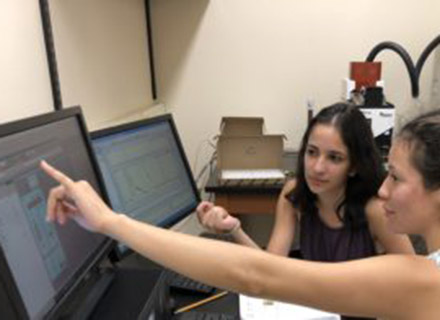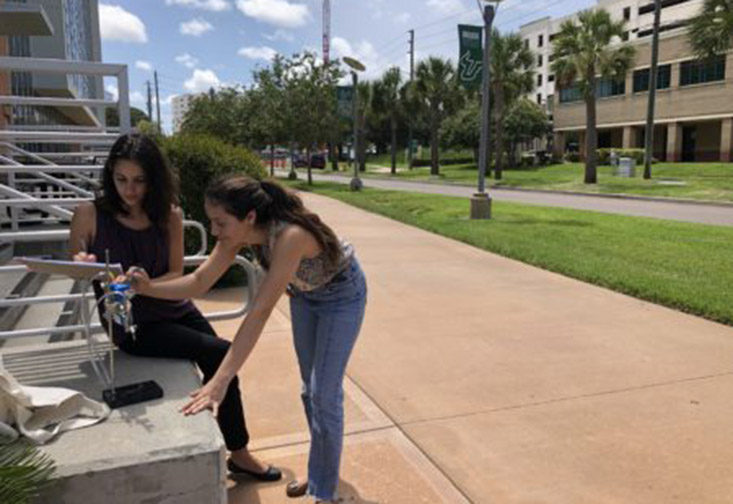Unlike sprawling metro areas like Los Angeles and New York City, southwest Florida is often lauded for its air quality. The sunny, breezy environment seems to fill our air with freshness.
Two USF St. Petersburg undergraduate students spent this summer seeing if that characterization holds true, studying the health of our air in the Tampa Bay Area. Working in the Atmospheric Chemistry and Climate Laboratory of Yasin Elshorbany, a chemistry professor and former NASA scientist, students Frances Rodriguez and Shayra Antia used thermal desorption (TD) and gas chromatography (GC) mass spectroscopy (MS) technique to measure levels of pollutants in the air around the campuses of USF St. Petersburg and USF Tampa. These atmospheric pollutants can contribute to climate change.
The long-term goal of the research will be to test the impact of greenhouse gases and aerosol particles on climate change.
For the summer project, the students set up their sampling devices to capture air pollutants at a few locations on each campus. In St. Petersburg, the sampling devices were stationed near the University Student Center, the new residence hall and along the water by Albert Whitted Airport.
Final results are not immediately available but initial GC/MS data suggest there was less contamination towards the bay, due to westerly and south westerly winds that blow off the ocean.
“That is what we expected because where there are fewer cars, there should be less contamination,” said Rodriguez, a senior biology major at USFSP. Although initial results suggest campus has poorer air quality than the bay, she said, “it was not as high as we expected.”
At USF Tampa, the students set up their sampling device near the Byrd Alzheimer’s Center and Research Institute and the BRIDGE Healthcare Clinic.
“We wanted to contrast air quality for students versus patients,” said Rodriguez.
The Byrd Center is primarily used by staff and students, while the BRIDGE is frequented by patients. The student researchers are still waiting on the results of their measurements in Tampa.
Rodriguez is participating in two other on-going research projects at USFSP: testing different pharmaceuticals for chronic asthma patients and conducting research on HIV prevalence in minority populations in Florida. She said the air quality study was a welcome challenge.

“I’m used to working in the biomedical field, so this was a big change for me to do environmental science,” she said. “I’m excited to learn more about it.”
Rodriguez encouraged other students to get involved with research in Elshorbany’s Atmospheric Chemistry and Climate Laboratory. It isn’t for the faint of heart, but the work is satisfying.
“It takes a lot of dedication and hard work,” she said. “Sometimes it’s frustrating because you don’t usually get the result you want, but don’t give up.”
The research conducted by Rodriguez and Antia is connected with Elshorbany’s broader research into the impact of aerosols on the atmosphere. Last year, Elshorbany was awarded an $800,000 grant from the National Science Foundation that will be used to collect and analyze air pollutants, including aerosol particles, from breaking waves at the Tudor Hill Marine Atmospheric Observatory in Bermuda. Elshorbany and his team will use measurements collected during this study to create better computer models, which may help scientists better predict how the climate will change in the future.
“First we use measurements to calculate what is in the atmosphere, then we use models to calculate how this will impact the atmosphere in the future,” Elshorbany said. “Having a better understanding of the chemistry of the gas and aerosol particles will help us develop better global atmospheric models that are able to more accurately predict the oxidation capacity of the atmosphere, and thus climate change.”
